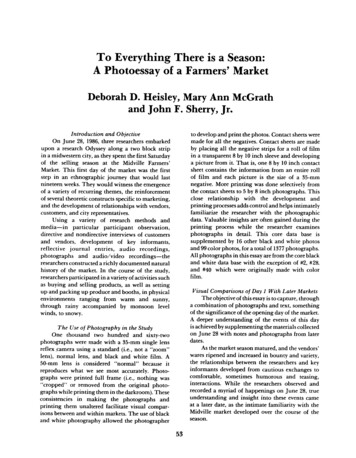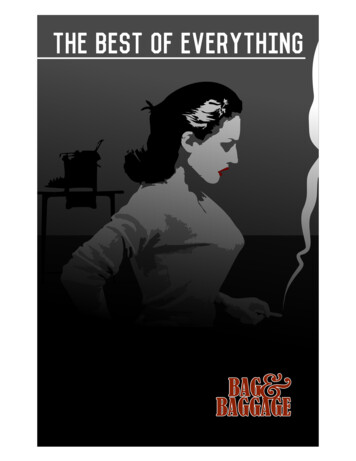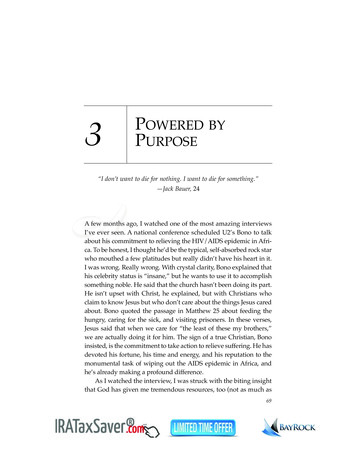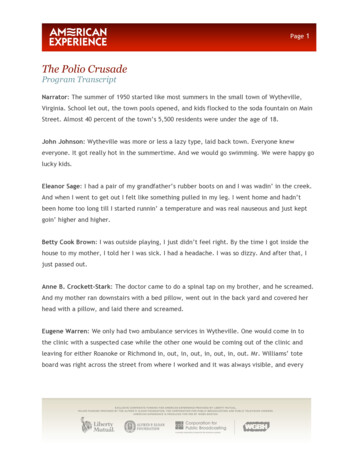
Transcription
To Everything There is a Season:A Photoessay of a Farmers’ MarketDeborah D. Heisley, Mary Ann McGrathand John F. Sherry, JrZntroduction and ObjectiveOn June 28, 1986, three researchers embarkedupon a research Odyssey along a two block stripin a midwestern city, as they spent the first Saturdayof the selling season at the Midville Farmers’Market. This first day of the market was the firststep in an ethnographic journey that would lastnineteen weeks. They would witness the emergenceof a variety of recurring themes, the reinforcementof several theoretic constructs specific to marketing,and the development of relationships with vendors,customers, and city representatives.Using a variety of research methods andmedia-inparticular participant observation,directive and nondirective interviews of customersand vendors, development of key informants,reflective journal entries, audio recordings,photographs and audio/video recordings-theresearchers constructed a richly documented naturalhistory of the market. In the course of the study,researchers participated in a variety of activities suchas buying and selling products, as well as settingup and packing up produce and booths, in physicalenvironments ranging from warm and sunny,through rainy accompanied by monsoon levelwinds, to snowy.to develop and print the photos. Contact sheets weremade for all the negatives. Contact sheets are madeby placing all the negative strips for a roll of filmin a transparent 8 by 10 inch sleeve and developinga picture from it. That is, one 8 by 10 inch contactsheet contains the information from an entire rollof film and each picture is the size of a 35-mmnegative. More printing was done selectively fromthe contact sheets to 5 by 8 inch photographs. Thisclose relationship with the development andprinting processes adds control and helps intimatelyfamiliarize the researcher with the photographicdata. Valuable insights are often gained during theprinting process while the researcher examinesphotographs in detail. This core data base issupplemented by 16 other black and white photosand 99color photos, for a total of 1377 photographs.All photographs in this essay are from the core blackand white data base with the exception of #2, #28,and #40 which were originally made with colorfilm.Visual Comparisons of Day I With Later MarketsThe objective of this essay is to capture, througha combination of photographs and text, somethingof the significance of the opening day of the market.A deeper understanding of the events of this dayis achieved by supplementing the materials collectedon June 28 with notes and photographs from laterdates.As the market season matured, and the vendors’wares ripened and increased in bounty and variety,the relationships between the researchers and keyinformants developed from cautious exchanges tocomfortable, sometimes humorous and teasing,interactions. While the researchers observed andrecorded a myriad of happenings on June 28, trueunderstanding and insight into these events cameat a later date, as the intimate familiarity with theMidville market developed over the course of theseason.The Use of Photography in the StudyOne thousand two hundred and sixty-twophotographs were made with a 35-mm single lensreflex camera using a standard (i.e., not a “zoom”lens), normal lens, and black and white film. A50-mm lens is considered “normal” because itreproduces what we see most accurately. Photographs were printed full frame (i.e., nothing was“cropped” or removed from the original photographs while printing them in the darkroom). Theseconsistencies in making the photographs andprinting them unaltered facilitate visual comparisons between and within markets. The use of blackand white photography allowed the photographer53
54Journal of American CultureFig. 1. The Midville Farmers’ Market.Fig. 2. A researcher, laden with goods from being a participant consumer at the market, conducts an interview under an umbrelladuring a rainstorm.
A Photoessay of a Farmers’ MarketIn this essay, the focus is upon the photographsand field notes from this first day of the market.Photographs of the first market day, June 28th, areused in the first part of this paper to illustrate anddocument interpretations of the market day and ofcustomer and vendor behaviors. When photographsof later markets are compared with this day’s shotslater in the essay, the dates are noted. The abilityto compare and contrast findings on various days,and document findings over time, became a notablebenefit of long term field immersion.Using photographs and accompanying fieldnotes from the first market day, the cycle of a marketday can be illustrated and documented, as it proceedsfrom set up to close. The ethnographic present tenseis used in the description.The Cycle of the Market DayAt 5:30 a.m. the streets of Midville are virtuallydevoid of cars and people. In the emerging lightof dawn a single truck is parked at the market site.A mother and her two adult sons are unpackingtables and setting up produce for a display. Theyevince a degree of pride in being the first to arrivetoday. As they work, they reminisce about theirparticipation in the first Midville Farmers’ Marketin 1975.There were only three farmers there that day. We went hometwice for refills.At this first market of 1986 they are sellingcarrots, beets, green beans and lettuce. Theyanticipate that they will “sell out early,” prior tothe 2:OO p.m. market closing time. They complainthat they have been allowed to rent double spacesin previous years, but that this year they arerestricted to a single 25 foot long space. For a rentalfee of 110 payable to the city, vendors will occupythis space for the duration of the market season.A total of 40 spaces have been marked off on bothsides of a two block long section of street.By 6:15 a.m. there are 15 vendors setting upin the market area. The city police and tow truckshave cleared the street of four parked cars that arein violation of posted no parking signs. As thelayout of the market has changed from the previousyear, vendors are jockeying for space and there isdiscussion of the boundaries, most notably theappropriate width, of each booth. Since this is thefirst market of the season, the vendors seek toconfigure the equipment they have brought todisplay and protect their wares (tables, umbrellas,shelves) to the space available and to prepare theproduce for sale.55As the farmers turn their booths into retailselling areas, they work continuously, yet this isa social time as well. Several of the farmers knoweach other and have worked side by side at thismarket and at others for years. The Midville Markethas last met eight months ago, so this first marketbecomes a setting for the renewal of friendships andfor catching up on what has happened over thewinter.Customers begin arriving by 6:30 a.m., and themarket is in full swing by 7 a.m., even thoughposters and signs posted by the city indicate thatthe market opens at 8 a.m. It is warm, sunny andclear. Customers exchange greetings with vendors,whom they have not seen for eight months, andvisit with acquaintances along the market midway.By 10 a.m., the warm sun is engulfed by clouds,and the overcast morning becomes cooler. Thecrowd continues to grow, reaching its peak around11:OO a.m. The majority of customers are white,with an estimated 10 to 15% minority populationmade u p of Asians, blacks, and hispanics. Thedistribution of ages is wide and varied, with allgroups being represented except teenagers. Thepresence of children in the infant and toddler agegroup is evident to consumers trying to negotiatethe midway because of the many strollers andwagons in the market area.After noon the market becomes quieter. Thecrowds have thinned, and several vendors have leftearly after either selling out or having their stockdepleted to levels too low for what they perceiveto be an adequate display. The afternoon becomeshot and clear, giving both the remaining produceand the vendors who have been standing for hoursa wilted appearance.At precisely 2 p.m., the Market Master removesthe barricades blocking traffic access to the streetand formally ends the market. At a later date theresearchers learn about post-market, after hourssocializing. Several vendors have lunch together ata local restaurant.Consumer Behavior at the Midville MarketExamination of the photographs of the June28 market day and subsequent interviews with keyinformants at later market dates reinforced theresearchers’ sense of the cyclicality of the marketday. On this first day all of those who wouldeventually become key informants are present andphotographed at the market. On June 28, however,the researchers were not cognizant of the role thateach customer or vendor would assume in the study.The photographs of this first market were a naiveattempt to capture thoroughly the visual aspects
56Journal of American CultureFig. 3. A researcher works at a vendor’s booth as part of her participant observationFig. 4. The first vendor to arrive, a mother with her two adult sons, begins to unpack and set up.
A Photoessay of a Farmers’ MarketFigs. 5 and 6. Early set up on the first market day.57
58Journal of American Cultureof the market. There were no specific hypothesesor predispositions associated with this first day. Anattempt was made to document the event throughphotographs and notes. Researchers did have anacute awareness of the transient nature of themarket, its customers and the day itself, and it waswith this awareness that photographs were madeof vendors and customers present in the marketplace. The two researchers worked separately duringa significant portion of the day, and severalphotographs made by one researcher were of personswho later became key informants of the other.Later interviews with several key informantsallowed the researchers to characterize the customersat the market by the time of day these customerschose to attend. The following is a chart of theetic segments.600 to 730 a.m. The Die-Hards. These people attend everymarket, regardless of the weather or selection ofproducts available. They want the freshest and the bestselection.730 to 9:OO a.m. The Sociable Die-Hards. This group ismore social than the first. They want good selection,but they also want to visit with friends. They considerthemselves “early birds.”9:00 to 11:OO a.m. The Very Social. These consumers arrivewhen the midway of the market is most crowded. Thereis still fairly good product assortment, but “the best”has already been purchased.11:OO a.m. to noon The Lute People. These people are oftwo types: those who complain that they are late, andthose who do their market shopping after they havefinished other errands. The socials have missed theirfriends. The purchase selections ‘at this time periodare not and cannot be very picky.1200 to 200 p.m. The Bargain Hunters and Night People.At this time of day, more minority group membersand college students are in evidence in comparisonto the white, middle-aged, middle-class complexionof the previously detailed groups. This later groupdoes little socializing and shops in a less crowdedmarketplace.Certain customers note a preference to come to themarket at a specific time of day.at the market site, they will visit if they meet theirfriends, and there is no observable evidence ofshoppers rushing to complete their shopping inorder to leave the market site.Look at us. We were an hour late today, and now we’vestood and talked for another hour. We had better start shoppingsoon, or we’ll never leave.The time sense of some consumers, andcertainly that of the researchers, appears tocorrespond to the periodic nature of the farmer’smarket itself. Some sense of urgency and immediacyis produced by time compression. Consumers knowthat the freshness of the produce is a function ofthis periodicity; abundance and scarcity ofindividual items are daily and seasonal conditions.So, also, is the intensity and regularity of outdoorsocial relations governed by the seasons. Midvilleresidents cherish the bounty of summer in the faceof brutal midwestern winters; they know full wellthe market and its charm are evanescent. Theresearchers are acutely aware that they themselvesmust seize the day if they are to capturecomprehensively the character of this periodicmarket.Photographs of this first market meetingillustrate that the Midville Market is more than aplace to shop for farmers’ wares. Two musiciansbegin to play around 10 a.m., and open theirinstrument cases for donations.A young man with a tricycle type ice creamcart parks near the musicians. In the absence ofcustomers, he begins to juggle three balls. Severalphotographs show customers taking a break fromtheir shopping and visiting at the market whileresting on the grass or in a shady spot nearby.Consumers readily admit that they come to themarket for reasons other than product assortmentor to restock ingredients for physical sustenance.This is recreational shopping. I’m here to try to amuse thekids. (Commentsof a father with children aged 3 and 1.)It’s social, and people come for the gladiolus.We come religiously at seven each Saturday.We’re late today. I don’t like the nine o’clock people.They’re too pushy.I usually come late, around eleven, when my other errandsare finished.In general, consumers make mention of being late,rather than of being early or on-time. Theirawareness of being late did not seem to alter theirshopping or socializing behavior, however. OnceThe cycle of this market day repeats itself onsubsequent Saturdays.In retrospect, it is this first Saturday that isexceptional in that customers and vendors appearto know and act out the script of the market withoutquestion after an eight month hiatus. It is theresearchers who do not fully understand the plotand significance of the activities unfolding. Afterseveral weeks of building trust in relationships with
A Photoessay of a Farmers’ MarketFig. 7. Vendors decide how to display their wares.Fig. 8. Vendors prepare their wares for display.59
60Journal of American CultureFig. 9. Two vendors visit early on the first market day.Fig. 10. Customers and vendors renew their acquaintances. A local nonprofit group sells coffee and bilked goods at the south endof the street, and this area becomes a gathering place as customers consume ret*eshmenr Iuie they sociallze.
A Photoessay of a Farmers’ MarketFig. 11. Customers socialize at one of two bake sale booths.Fig. 12. Children in and with strollers and wagons fill the market midway.61
Journal of American Culture62Fig. 13. As the end of the market day approaches, stock is depleted, and vendors and remaining produce begin to wilt.Fig. 14. At 200 p.m., the market formally ends.
63A Photoessay of a Farmers’ MarketFig. 15. The Die-Hards.Fig. 16. The Sociable Die-Hards.
Journal of American Culture64Fig. 17. The Very Social.Fig. 18. The Late People.
A Photoessay of a Farmers’ Marketinformants, the researchers are able to documentand interpret this script.Differing Perceptions of Abundance andComplexityPhotographs of the first market of the seasondocument the transformation of an empty street intowhat may appear to be a cornucopia of abundance.A journal entry of June 28 notes that “the colorsof the market were dominated by pinks, reds, brightgreens and yellows, the colors of spring.” Tablesappear heaped with merchandise and consumersmention specific items they plan to purchase(asparagus, mushrooms, gladiolus, etc.). Whileresearchers perceive bounty and abundance in themarketplace, the vendors speak of anticipatedbounty nearer the late summer and fall harvest time.Vegetable farmer Mrs. Theopolis mentions that shewill open a roadside stand at their farm in the fall.Fruit vendor Maggie Moran tries to recruit anemployee to help at this market later in the season,“when we have bushels of apples.” The researchersbetter understand the significance of these remarksthrough observations of abundance and morecomplex assortments and displays at the latesummer and autumn markets.A series of photographs visually documentssignificant changes in assortment, abundance, andcomplexity of display. Photographs 25 and 26 allowa comparison of two-thirds of Blake’s booth at thefirst (648) market with one-third of his booth atthe thirteenth (9120) market. The increasingabundance and complexity of display are illustratedas the tables evolve into two tier displays, signs arein greater evidence and detail, and produce is ofgreater quantity and variety.Photographs 27 and 28 further documentincreasing abundance and complexity of displayevident in the Wilcox booth at the second (7/5)market and the fourteenth (9127) market. Bothphotographs include the entire display. Like manyvendors, Wilcox’s display area spills over theboundaries of his designated area as the seasonprogressed.In photographs 29 and 30, the Theopolis boothis documented on the second and eleventh markets.In the photograph of the Theopolis booth on secondmarket d a y (7/5), several tables are lined up facingEast. Mrs. Theopolis is waiting on a customer. Onthe eleventh market day (916)the photograph showsMrs. Theopolis waiting on a customer on theSoutheast side of a booth which is now shaped likea horseshoe. The increased abundance of produce,complexity of booth display, and number of signsis evident in this comparison.65Photographs 31 and 32 are a series taken ofMrs. Blake’s booth on the second market day (7/5), and the last market day (1l/l), respectively. Thebooth evolves from a straight line of tables facingEast, to a much-expanded corner booth set-up withthe tables facing East and North, and finally, onthe last day of the market, to a free form style withproduce piled wherever i t can be placed. Again,increasing abundance and complexity is apparent.The Jameson family often exhibits complexdisplay configurations, as are illustrated inphotographs 33 and 34. On the second day of themarket (715) the Jamesons have mounted a multilevel display effort (Photo #33). By the fifth marketday (7/26) the booth has evolved into a horseshoeshape that, unlike other vendors’ horseshoes, is opento the market and designed to entice customers toenter. Other vendors enclose themselves with thehorseshoe configuration, keeping customers on the“outside.” By the seventh market day (8/9), theJameson booth has become the most complex ofthe market. It now exhibits a horseshoe designaround a central display area, and is open to themarket. A sign invites the customers to “Walk onin.” In addition to the increased complexity of thebooth, increased abundance is evident as well.An impression gleaned from interviews is thatthe farmers make a perfunctory appearance at theearly markets to establish their presence among theirregular customers, but that they do not anticipatetheir busiest or most profitable market days untillater in the season. Attendance figures were not ashelpful in demonstrating this as they wereanticipated to be. Attendance at the first market byvendors is 70%, with 28 of the 40 assigned spacesfilled. At the height of the harvest season inSeptember, attendance increases to 32 vendors, or80%of the available spaces. Four additional farmerswho participate in the market at the start of theseason cease to attend due to flooding of their landsand also being “harvested out” of the crops theyhave chosen to grow, most notably corn. Consumerattendance estimates were not recorded.Habituation of Key Informants to Researchers’PresenceSeveral vendors and customers became keyinformants during the course of the study. A pictureof each of these key informants was made at thefirst meeting of the market, though at the time theirsubsequent significance to the study was not knownto the researchers. Journal entries and photographsof these informants on the first day of the marketare contrasted with photographs made near theconclusion of the study. The use of a standard lens
Journal of American Culture66Fig. 19. The Bargain Hunters and Night People.Fig. 20. Entertainment at the Market.
A Photoessay of a Farmers’ MarketFigs. 21 VS. 22. Early and late photos of two vendors OEI this first day visually reveal the depletion of stock and consolidationthat occurs over the course of a market day.67
68Journal of American CultureFigs, 23 VS. 24. Early and late photos of two vendors on this first day visually reveal the depletion of stock and consolidationthat occurs over the course of a market day.
A Photoessay of a Farmers’ MarketFigs. 25 VS. 26. Blake’s booth at the first (6/28) market and at the thirteenth (9/20) market.69
70and full-frame printing gives full and consistentinformation about the photographer’s position inrelation to the informant. Therefore, validstatements and comparisons about this relation canbe made. The comparisons reflect the levels of trustthat developed between participants and researchers, that in turn led to a negotiated orcollaborative interpretation of marketplacebehavior.In the earlier pictures, the informants assumethe posture of unknowingly being photographed,ignoring the photographer, or of suspicion towardthe camera in particular or toward the researchersin general. In the later photographs, the friendlyrelationship with the photographer/researcher isevident. The informants in the later photographsare smiling and demonstrate a tolerance of thecamera and a willingness to be photographed.Differences are evident in the facial expressions, thepresence of or absence of eye contact and posingof the body, and the angle of the bodies with respectto the camera. Several photographs demonstratenotable contrast between the first and later markets.A photograph on the first market day is aphotograph of strangers. Photographs of vendorsare distant, removed shots. Photograph 39 is a firstmarket day shot of a vendor who was later to becomea valued informant. Circled, in the background ofthis photo, a man is looking with skeptical curiosityat the photographer. This man, we learned later,is the market manager, Tom McKensey. Tombecame another of our most valued informants. Thedegree of rapport between the photographer andher informant, as well as that between another ofthe researchers and her informant .are evident inthe spatial relationships demonstrated in photographs 40 and 41; the former was made on the fifthmarket day (7/26), the latter on the sixteenth marketday (10/1 1).Another visual demonstration of the relationship between researcher and informant is acomparison of photographs 42 and 43. The firstis of Mr. and Mrs. Theopolis on the first day ofthe market. Mrs. Theopolis is looking at the camerain a detached, distant manner. Conversely, in thephotograph on the sixteenth (10111 ) market day sheexudes warmth and friendship. She has clearlybecome involved in the research process. Note too,once again the photographer’s posture toward theinformant has changed. That a greater degree ofintimacy has been achieved is evident in thephotographer’s ability to be physically close to herinformant with a potentially intrusive and invasiveobject (i.e., the camera) without being perceived asa hostile aggressor.Journal of American CultureSome concern has been voiced withinmarketing that researchers should be concernedabout using audio and video recording tools becausethey are obtrusive, they call attention to the presenceof the researcher, they may alter behavior, andbecause there is an ethical issue if the recordingsare made secretly, so as to be unobtrusive. However,visual researchers and audio/visual ethnographersbelieve that (1) certain patterns of behavior persistthat will be informative, (2) a skillful audio or visualrecorder will use the recording process to establishrapport between the researcher and the informants,not to spy on the informants, and (3) if the natureof the research calls for accurate on-site recording,then audio, visual, or written recording are thechoices-audio and visual recording not beinginherently more obtrusive than scribbling away ina notebook. In this study, a combination of visualrecordings (the photographs) was supplementedwith written notes and audio recordings. A limitedamount of videotaping was undertaken on 7/26,the day a visiting team of researchers attended themarket. In all cases the researchers explicitlyrevealed to informants the purpose of their study,freely answered questions, and shared photographsand notes with all involved in the study.The Emergence of Znformed Field NotesField notes of the first market may be describedas naive and uninformed. An attempt was madeto document as much as possible, but thecommitment that the researchers had made toremain at the site during the duration of the marketseason reassured them that they would be able tosupplement their observations or change their focusat a later date. Inventories of specific items andprices were started at the fourth market, when thatinformation was deemed relevant. The researcherengaged in fewer, but longer, conversations atsubsequent markets. As relationships with keyinformants developed, these informants wouldconsume more of the researchers time each week.Informants would frequently watch for theresearchers at the market each Saturday. Oneconsumer informant in particular would thinkabout the market each week, and come to thefarmer’s market on Saturday prepared with insightsand stories to share with the researchers.Researchers became more involved with thevendors as the study progressed. On the last dayof the market, vendors who are key informants arethanked and given photographs of themselves madeby researchers. Many vendors give the researchersgifts as well. Relationships have developed, as canbe seen in Photographs 39 and 40. Photograph 39
A Photoessay of a Farmers’ Market71 Figs. 27 VS. 28. A comparison of comprehensive photographs of the Wilcox booth on the second (7/5) and the fourteenth (9127) markets.
72Journal of American CultureFigs. 29 VS. 30. The Theopolis booth on the second market day (7/5) and on the eleventh market day.
A Photoessay of a Farmers’ MarketFigs. 31, & 32. Mrs. Blake’s booth on the second market day (7/5), and the last market day (ll/l).73
74Journal of American CultureFigs. 33, & 34. The evolution of the Jameson family booth on the second market day (7/5), and the seventh market day (8/9).
A Photoessay of a Farmers’ MarketFigs. 35 & 36. The habituation of key informants to the presence ot the researchers evolves from the first market (6/28), andalters over the duration of the study (10/11).75
76Journal of American CultureFig. 37 VS. 38. The changing relationship between photographer and informant is illustrated in photographs of the Mr. andMrs. Theopolis at the first (6/28) and the eleventh (10A 1) markets.
A Photoessay of a Farmers’ MarketFigs. 39, & 40. Informant posture at the first market (6/28) contrasted with a gift-exchange at the last market (ll/l).77
78Journal of American CultureFig. 41. “The Walking Plant.” A customer leaves the market accompanied by a newly acquired companion.was taken near the end of the first market day (6128). The photographer makes an attempt to movecloser to her subject and is waved away with a scowl.On the sixteenth market day (10/11)‘he poses forthe photographer with an unshucked pussywillowin his right hand and the finished product in hisleft hand. He has just patiently taught her his artof shucking. On the last day of the market, shegives Otis and his wife Andrea some photographsmade of their booth over the season. In turn, hemakes the photographer a grapevine wreath withwhich to remember them (Photo #40).The leavetaking was an emotional experience,as one researcher notes in a final journal entry:I had a lump in my throat as I said good-bye to everyone.I am grateful that I have gotten to know the farmers, and Ivalue the trust they have demonstrated toward me. . .The markethas changed me-the way I shop, the way I eat, and the wayI do research. I will miss these people.ConclusionsThis essay has illustrated how impressionsformed early in an ethnographic study can, whenviewed later in context, provide useful insights intothe processes of interest to researchers. Thechanging relationships with key informantsclarified and enhanced several of the initialimpressions formed by the researchers. Theseestablished bonds helped produce a negotiatedinterpretation of marketplace behavior. Thatenthnographic research is a labor intensive processthat emerges over time is demonstrated in this essay.The incorporation of several, sometimes opposing,perspectives of a phenomenon over time yielded adeeper understanding of the setting and itsparticipants that was not evident on the first d a yof the market.On day one, we caught a colorful, noisy,fleeting glimpse of the budding market. Had wenot continued to attend and observe, we might havemistaken the market as being in full flower. Ourview of the vendors was as romantic and idealistic,independent, self-sufficient Americans engaged inan archaic, but quaint lifestyle. We perceivedshoppers as a homogeneous group. We witnessedthe market spring up, akin to a mushroom; we hadno understanding of the historical and structuralcompost that formed its basis and nurtured its
A Photoessay of a Farmers’ Marketeventual blossoming.By the last day of this nineteen week study,we had seen the market mature, ripen, andculminate with the onset of the killer frost and thewinter chill. Our understanding of the marketencompassed not only its flowers and its fruits, butalso its roots, its chaff, its fodder, and its seeds. Atthe conclusion of the study, we had greaterunderstanding of the issues of complexity,cyclicality, and abundance. We saw the market asa complex system, interacting with the local citygovernment, local retailers, and several marketsegments in the community. We learned about thefarmers’ business acumen; they were recognized asmarketers, rather than m
restricted to a single 25 foot long space. For a rental fee of 1 10 payable to the city, vendors will occupy this space for the duration of the market season. A total of 40 spaces have been marked off on both sides of a two block long section of street. By 6:15 a.m. there are 15 vendors setting up in the market area.











